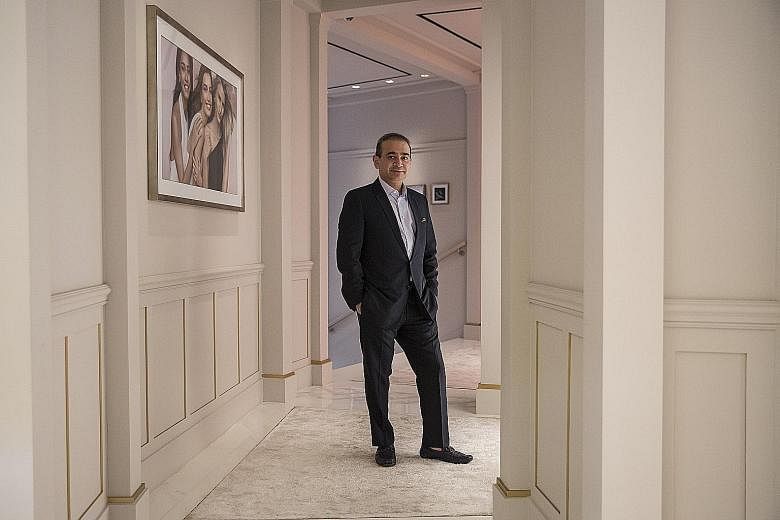NEW DELHI • Nirav Modi brightened actress Kate Winslet's earlobes and made actress Taraji P. Henson's collarbone glitter.
A jeweller to the stars, Modi attained wealth and fame at home in India in a few short years. He socialised with British royalty and rubbed elbows with Mr Donald Trump Jr, the son of United States President Donald Trump.
He opened an opulent outlet on Madison Avenue in New York. In January, he met Mr Narendra Modi, India's Prime Minister and no relation, at the annual gathering of the world's elite in Davos, Switzerland.
Today, he is on the run.
About a week after Modi grinned for the cameras with the prime minister, a state-run Indian bank told regulators that it had found nearly US$1.8 billion (S$2.4 billion) in fraudulent transactions linked to the jeweller's account.
Indian officials now accuse Modi, his family and business associates of assembling a global empire with nearly US$3 billion in money obtained illegally, mostly from government-run banks. He denies wrongdoing.
The chase has enraged and captivated India at a time when the public increasingly believes the country's debt-laden government banks are enriching its flashiest, most corrupt business tycoons.
Parliament sessions have deteriorated into screaming matches, with political opponents exchanging accusations of collusion with the jeweller.
Finding Modi has become something of a national pastime. Reporters in New York camped outside a luxury hotel, the JW Marriott Essex House, where they believed he was staying. One who rang the bell outside what they believed to be his room found only a servant and a fluffy white dog.
The allegations against Modi have only strengthened people's wariness of the state banks. Indian officials have publicly accused him of working with tellers at a single branch of one of them, Punjab National Bank, to obtain US$1.8 billion from branches of other banks.
So far, five Indian banks have been swindled in the scandal, four of them government-owned, the authorities in New Delhi say.
Of the US$6.5 billion in fraudulent loans that have hit the industry over the past two years, the most egregious cases were at government-owned banks, according to figures released by the Indian parliament. Executives at those lenders are more likely to be appointed for their political connections than for their talent, financial analysts say.
Modi's lawyer, Mr Vijay Aggarwal, denies his client defrauded banks and says there is only a misunderstanding over a much smaller loan worth about US$40 million. He accused the banks and government authorities of damaging his client's reputation and the Nirav Modi brand's value.
"This was a case of civil transaction which the authorities have converted into a criminal one unnecessarily," Mr Aggarwal said in an interview.
Diamond traders and jewellers have long marvelled at Modi's rise. Nicknamed NiMo in the press, from the first syllables of his name, Modi was known for wearing custom-made cuff links with the fish from Finding Nemo.
Born in Antwerp, Belgium, to a relatively small diamond-trading family, Modi attended the prestigious Wharton School of Business before dropping out at 19 to join the family business in Mumbai.
He first rose to international prominence in 2010, when he designed a necklace featuring a 12.29-carat diamond set with smaller pink diamonds. It was auctioned by Christie's in Hong Kong for US$3.56 million, nearly US$1 million more than its asking price.
The bidding war landed Modi on the cover of Christie's catalogue, the first Indian to be featured so prominently by the auction house. He formed his Nirav Modi brand later that year and announced plans to open 100 stores around the world by 2025.
His lifestyle rose with his fame, according to interviews with colleagues and friends and local news reports that tracked his purchases.
He bought a Rolls-Royce for family use. He had an aquarium built that covered an entire wall of his office. He bought an apartment in an exclusive, seaside high-rise called Sea Palace that is home to some of Mumbai's wealthiest people, including one of the founders of the information technology giant, Infosys.
But the authorities in New Delhi say he projected an image of success built on bank loans and fraudulent letters of understanding, part of a strategy to expand his business in the hope that profits would eventually outstrip debts.
"The arms of the law are long," said Mr Abhishek Dayal, a spokesman for the Central Bureau of Investigation, the main government body investigating the case. "We will get them."
NYTIMES

